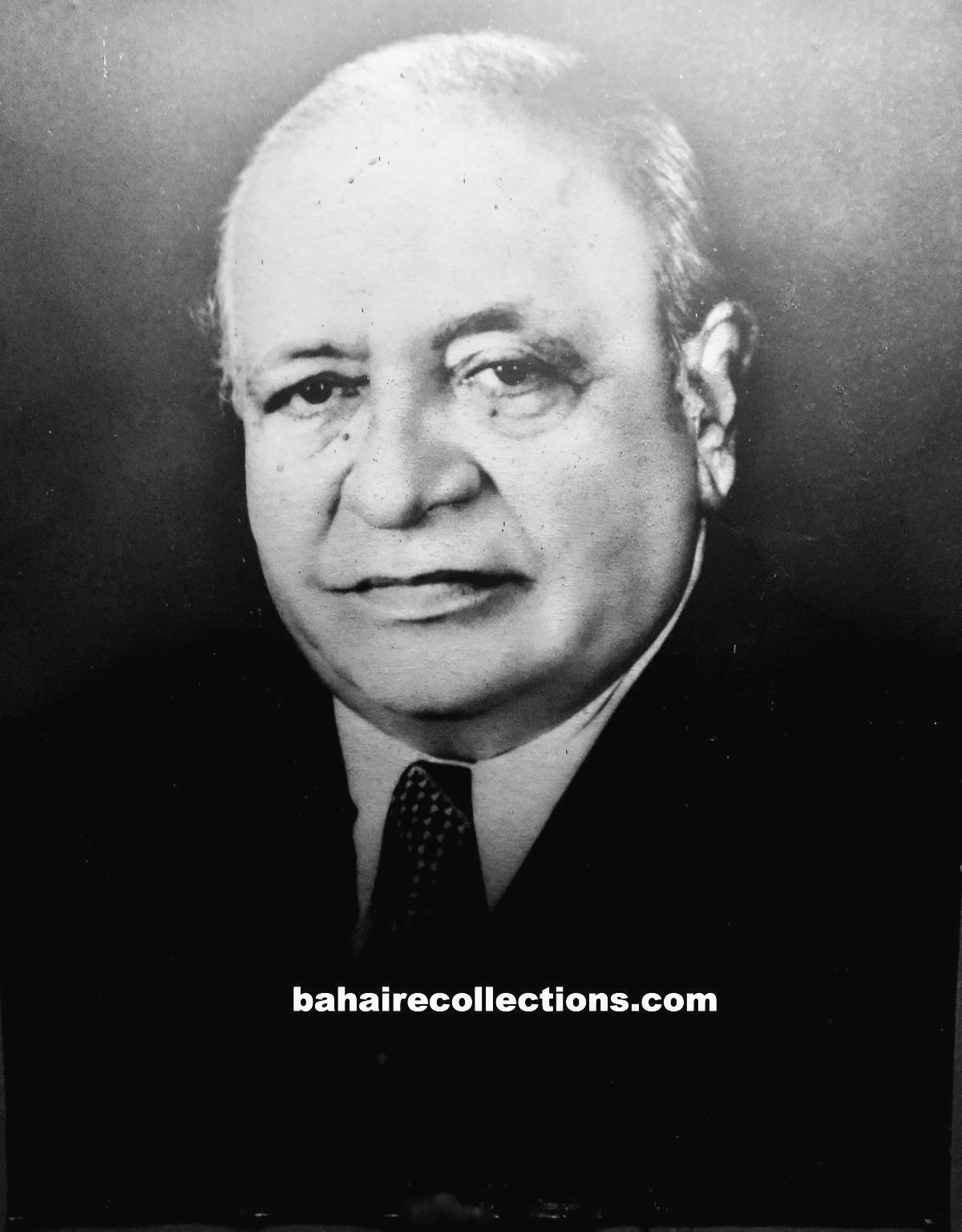REMEMBERING DR. H. M. MUNJE
27 November 1911 – 19 June 1989
This is a story of my dear father, Dr. Harilal Mehraji Munje or popularly known as Dr. H. M. Munje. My late husband Dr. Harry T. D. Rost (known as Tim Rost) began research on my father’s life and services with intention to write his biography. Sadly, with his unexpected passing the work could not be completed. I took over what he had started and collected information about Dr. Munje from various sources. It needs to be mentioned that this story of Dr. Munje who lived a full life of 78 years, filled with immense Bahá’í activities is in no way exhaustive. It is only an attempt to give some glimpses of the life and legacy of this great soul.
Dr. Munje as I wish to address my father in this story will forever be remembered in history as one of the Indian Bahá’í community’s most outstanding teachers, consolidators and scholars of the Faith. He was born in Bombay on 27 November 1911 to parents who were both noted Bahá’í teachers.
Munje’s father, Meher Ali, as a teenager travelled to Bombay with his brother and started a business in making and selling ‘topis’ (a cloth head-dress for Muslim men) and became famous as a ‘topiwala’. Meher Ali was deeply religious and a God-fearing man and was always searching for truth. He met some Christians who taught him about Christianity, and he became a Christian. In a short time, he met a Muslim who taught him about Islam, and he became a Muslim. Yet his spiritual thirst could not be quenched. He was destined to meet Jamál Effendi, an Iranian from Tunukábun in Mazandaran. Bahá’u’lláh had sent Jamál Effendi to India to teach the Cause, when the Afnáns of Bombay requested Bahá’u’lláh to send someone to teach the Cause there. When Jamál Effendi taught the Faith in Bombay, Meher Ali accepted the Faith immediately and his search for truth was completed.
How Mariam met my grandfather Meher Ali is another fascinating story. One of my grandfather’s friends knew Mariam who wanted to go for a Muslim pilgrimage. But she did not know how to go about it. Meher Ali wanted to help her and made arrangements to meet her in the evenings or during holiday at her home. When meeting Meher Ali she investigated more about the Bahá’í Faith and exchanged verses from the Qur’an and the Bahá’í Writings. After two years of search, Mariam accepted the Faith and married Meher Ali. A son was born in 1911 and he was named Harilal Munje, who later became known as Dr. H. M Munje. A new chapter began not only in his life, but by extension in the history of the Faith in India.
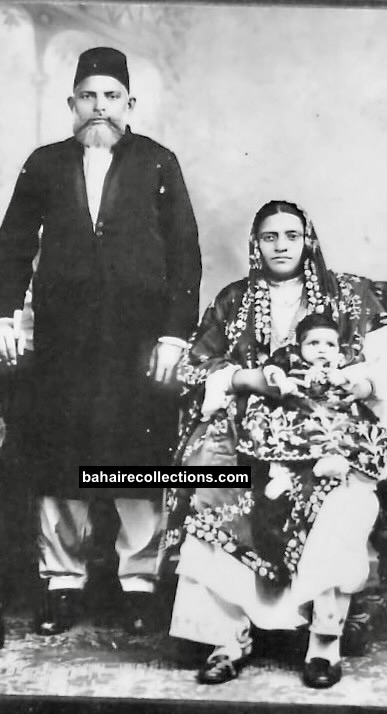
Infant Munje with father Meher Ali and mother Mariam.
EARLY DAYS OF MUNJE
Meher Ali observed that Munje was very intelligent with capabilities and rare skills. He advised his son to study all the scriptures of the world’s great religions and learn many languages. Munje at a very young age became an erudite scholar in all the major religions of the world and learnt 14 languages. He was able to read, write and speak in Hindi, English, Sanskrit, Urdu, Marathi, Gujarati, Persian, Arabic, Pali of the Buddhist Faith and Zand of the Zoroastrians with such a fluency that amazed everyone. Whenever he spoke in one of those languages, the listeners believed that he was a scholar in that language. When in Iran they took him for an Iranian. He had a high command of the English language as he was trained by reading the writings of the Guardian. He could recite the original Sanskrit verses and then present his own translation in English or Hindi, as required. Because of Dr. Munje’s proficiency in various languages, whenever translations were required he was called upon to translate the talks of the speaker.

A child Munje with his father Meher Ali.
Knowing several languages and religions enabled him later in life to teach the Faith to people of all different backgrounds and was able to prove the truth of the Faith. Dr. Munje also took his father’s advice to heart and made the Faith the only goal of his life. He even sought knowledge of the Faith from Bahá’í youth. When he was a young boy attending school, his father passed away. With his character of sticking to his goals, he continued his studies. He encountered many hardships during this time and had to study under the street lights and work to earn money in order to continue schooling. Dr. Munje worked for a real-estate person as an accountant-cum-manager and because of his honesty and hard work he could continue to pursue his job as well as his studies through self-study. Then working with a Homeopath doctor and getting hands-on practice, he became a Homeopath doctor.
MARRIAGE OF MUNJE
In 1936 Munje had saved up enough money and was able to send his mother Mariam Munje for pilgrimage to Haifa. She was the guest of Munirih Khanum and the Guardian for 6 months. While she was in the Holy Land she had made a vow to herself that she will have her son Munje married to the first proposal she receives. And true enough my mother Nalini was the first proposed for my father and the marriage took place.
My mother Nalini Irani was the youngest daughter of Mehraban Bomassy and Morwari Irani, Bahá’ís of Zoroastrian background. Zoroastrians do not marry non-Zoroastrians. The Zoroastrian priest warned them that if this marriage took place he would have them both killed. The two families consulted, and my father and mother went to the priest’s house with a marriage invitation card and some sweets. The priest was so transformed that, though he did not come for the wedding, he sent a bouquet of flowers showing his acceptance. The marriage took place in about 1937. His wife Dr. Nalini Munje is Shirin Boman’s younger sister. Shirin Boman was appointed on the Continental Board of Counsellors. Later Dr. Munje and Mrs. Shirin Boman worked hands in glove for the furtherance of the Cause.
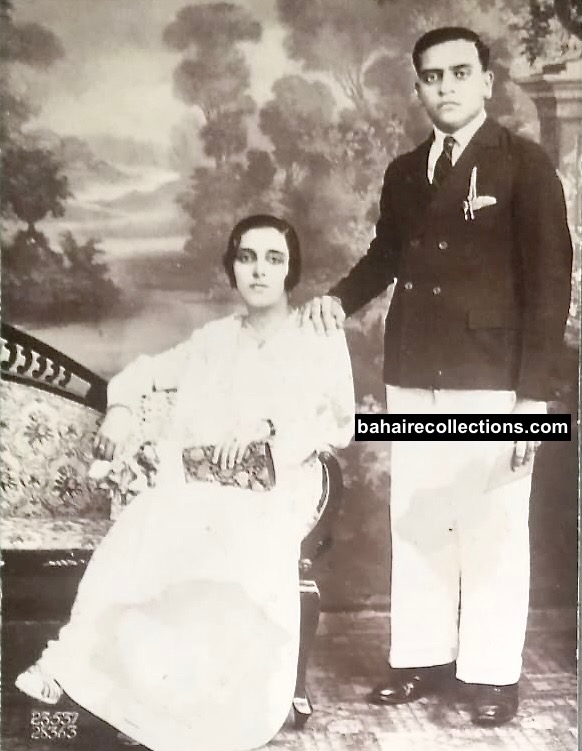
Just married
Dr. Munje and Mrs. Nalini had eight children, three of whom survived infancy and childhood, and were brought up to be disciplined Baháʼís of good standing. Their eldest son Mohan married Tuba Yaganegi of Bangalore. At the request of Hand of the Cause of God Dr. Muhájir, Mohan and Tuba went pioneering to Nepal and were instrumental in forming the first National Spiritual Assembly there. Upon return to India, they settled in Calcutta at the behest of Dr. Muhájir. Another son Ishwarlal could not pioneer or leave his hometown as he opted to look after our parents, but was an active believer. Ishwarlal married Faranghis Rahmanian, an Iranian Bahá’í serving at the New Era School in Panchgani in 1972. Unfortunately, Faranghis ascended to the Abhá Kingdom and had left one son Arun. Ishwarlal married after 10 years to Faigheh younger sister of Faranghis in 1982. And here am I, Radha, who married Dr. Harry T. D. Rost, an American pioneer in the Bahá’í Temple gardens in Uganda in 1971. As my parents would recall they were proud that all the three siblings were firm in the Faith and have added lustre to the Faith through their humble services.
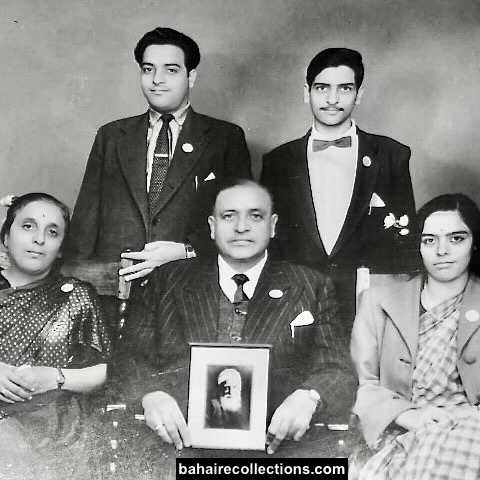
The Munje family in Kanpur, 1962. Seated L-R: Nalini Munje, Dr. Munje and Radha.
Standing, Mohan Munje at left and Ishwarlal at right.
HOMEOPATHIC PRACTITIONER
Both Dr. Munje and Nalini became homeopathic doctors, practicing first in Bombay and then at their pioneering post in Benares, Uttar Pradesh. The family happened to be the first believers to have settled in Benares for the period 1946 to 1947. While in Benares, the family faced many difficulties from thugs and thieves. But the spirit of the family remained strong with unshakable trust in God. In 1947 Dr. Munje moved to Kanpur.
In Kanpur often other doctors referred difficult cases to them for treatment, and many doctors themselves were Dr. Munje’s patients. One of the patients was an aunt of Sir Padampat Singhania, an industrial tycoon from Kanpur. Dr. Munje treated her and was later appointed the family doctor. The family then moved to Kanpur with address at Dr. Munje’s Clinic, Kishori Niwas, Birhana Road. There, the children were able to begin regular formal schooling. Mrs. Nalini Munje stayed in Kanpur most of the time while Dr. Munje was often travelling for teaching trips to almost all the States of India. Thus, Mrs. Nalini looked after the clinic and handled the affairs at home. With the invaluable help of my mother, Dr. Munje could be away for teaching for long period of time. Mrs. Nalini was truly a pillar in the community and an anchor in the family.
It was while in Kanpur that Dr. Munje helped establish a homeopathic medical college there. He also established a Bio-Science Research Laboratory and prepared many medicines such as his Goldium Tonic, Buti eye drops, Biovision, Dentogum tooth paste, Biolax and Nuvita. He patented several medicines. They were so effective that some of them are still in demand.
His medicines were so effective and popular that some homeopathic practitioners asked Dr. Munje to sell the formulas for a big amount of money. But Dr. Munje refused on the grounds that medicine should not be commercialised. He was a very firm believer in the homeopathy as a cure. He always carried in his wallet a statement that ‘Abdu’l-Bahá had mentioned on this branch of medicine and shared with people. There were several cases of patients who could not be cured using allopathic medications. Dr. Munje took them under his care in Kanpur and cured them and amazed everyone.
He valued his independent service to the Cause and wanted to stand on his own feet financially so that he was not dependent on the Bahá’í Fund. He would carry a box of medicines with him on his travels so he could work whenever there was time or opportunity. As for the patients from the deep villages of India, he would offer free treatment free medicines for them. Such was his magnanimity. But he never taught the Faith in the clinic during clinical hours. If anyone wanted to know about the Faith he explained only after the business hours, mostly at home.
A SCHOLAR
With the ability to read and write in the fourteen languages, Dr. Munje was able to get a vast ocean of knowledge available in those languages. As an example of his linguistic abilities, he translated The Hidden Words of Bahá’u’lláh from Arabic, Persian and English into Sanskrit. This book was praised by a professor of Sanskrit at Fergusson College as “reading just like the Vedas”.
It was in 1945 when he had pioneered to Varanasi the Hindu seat of learning and culture that he went into the heart of Hinduism and connected his findings with the Bahá’í Faith. Dr. Munje understood the philosophical pulse of the Hindu. He was tremendously interested in Hindu prophecies and was the first scholar to relate the advent of the Báb and Bahá’u’lláh to Hindu.
 .
.
Local Spiritual Assembly of Kanpur, 1952. Seated L-R: Dr. Munje, Mrs. Mariam and Mrs. Nalini Munje.
He discussed Bahá’u’lláh and Hindu beliefs at great lengths with Hindu pundits. Dr. Munje wrote to the beloved Guardian of his intention to do research and bring out some books about Hinduism and the Baháʼí Faith. The Guardian replied that this was a very laudable endeavor and assured him of his prayers, but also told him that the study of this ancient religion of Hinduism was going to be a very bewildering exercise.
Dr. Munje could also bring both Hindus and Muslims together, demonstrating to them that the two religions are one and the same when viewed in the right light and context. In his deepening classes Dr. Munje could convince the followers of both Faiths of the reality and coming of Bahá’u’lláh. He had the great ability to show the thread that connects the teachings of Buddhism, Christianity, Hinduism, Islam, and Zoroastrianism with the Bahá’í Faith. He just could speak with great elucidation and clarity about the other religions.

Visit by Hand of the Cause of God Miss Dorothy Baker to Kanpur, 1953. Seated L-R: Mrs. Nalini Munje, Dorothy Baker and Mrs. Mariam.
Frontmost row, L-R: Ishwarlal, Radha holding the signboard of Kanpur Bahá’í Centre, and Mohan. Dr. Munje stands at the back of Dorothy Baker.
Dr. Munje’s deep knowledge of the Bahá’í Faith, Buddhism, Christianity, Hinduism, Islam, and Zoroastrianism, and other religious teachings, enabled him to effectively convey the healing message of Bahá’u’lláh on various levels to what must have been hundreds of thousands of people over his lifetime. Dr. Munje had developed charts about the chain of prophets, right from the beginning of creation, and he explained the development of religion step by step, and identified each one of the world’s major religions. In Winter Schools, Summer Schools and Youth Conferences, audiences would be enamoured by his profound knowledge and his fascinating style of explaining subjects in great detail, especially when it came to prophecies and to understanding religious scriptures.
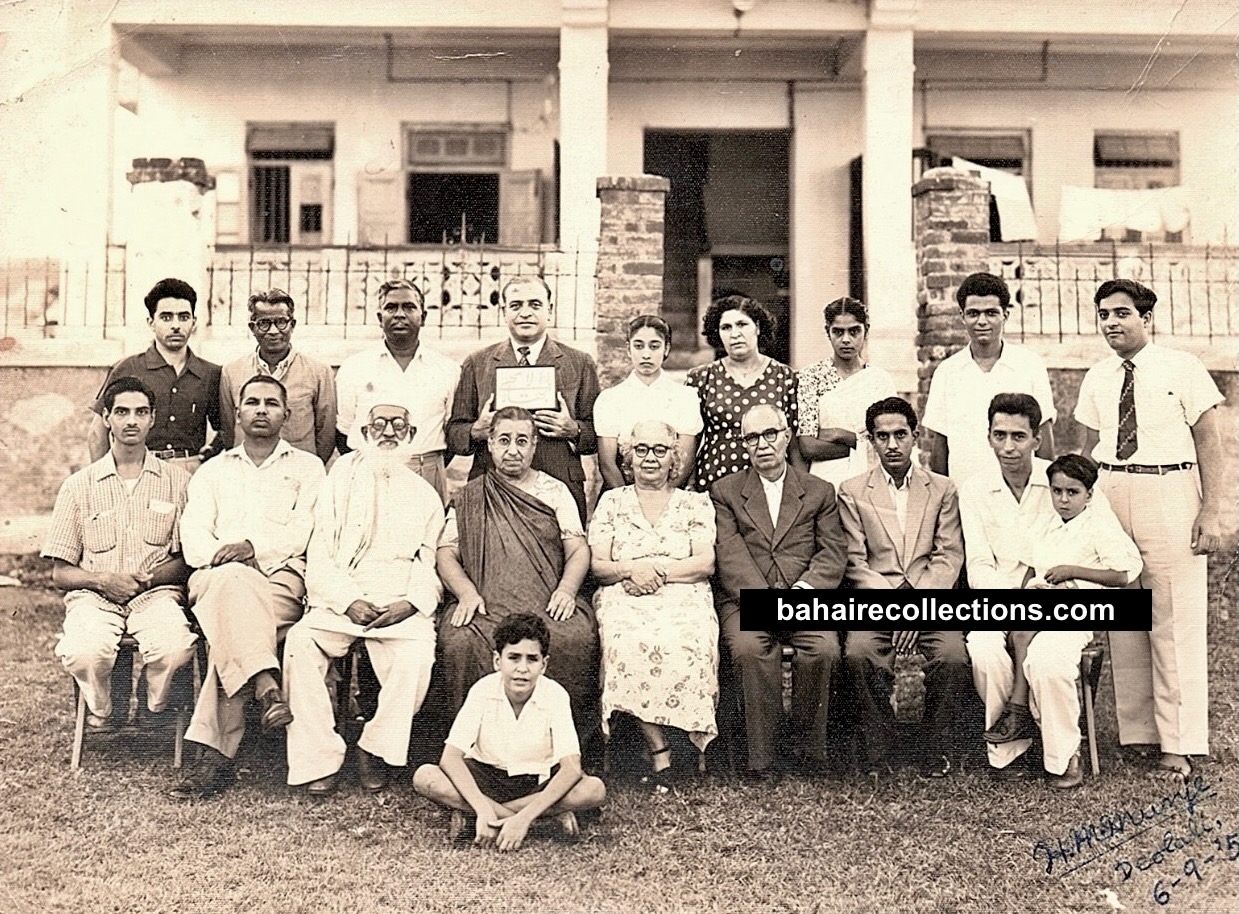
A gathering in Deolali in Maharashtra, 1957. Dr. Munje stands at the back holding the Greatest Name. Standing at the extreme right is Mohan Munje.
LITERARY WORKS
He wrote some important Bahá’í booklets, including “The Whole World is But One Family”. The booklet “1844: Pinpoint Target of All Faiths” was published in Malaysia for the first time in 1982, with the first Indian edition in 1987. The booklet begins powerfully with statements from Bahá’u’lláh proclaiming the greatness of this Day, the fulfilment of the promises of God as reassured in the Holy Scriptures, the appearance of the promised Manifestation, a new Revelation, a new world order, and a new creation. His other book, “The Reincarnation Mystery Revealed” is one more of his great works, in which Dr. Munje examines the origins of the doctrine of reincarnation in Hindu belief. Comparing these traditions with the Bahá’í sacred writings and the original Sanskrit texts of the Hindu sacred writings, he has brought a fresh outlook on the progress of the soul, both for Hindus and for followers of other religions. He also has added a chapter relating the Bahá’í Faith to Hinduism to the Indian publication of Bahá’u’lláh and the New Era in Hindi and English. At times he included his own important translation of portions of sacred scriptures, particularly from Hinduism, in these publications. A small booklet of a speech which he had given earlier in the city of Puri in Odisha was published in Bhubaneswar in both English and Oriya languages. He had contacted several Indians in high positions who wrote a few laudatory things about the Faith, which he collected.
BOOK WORM
Over the years Dr. Munje had accumulated numerous books and arranged them in his personal library, as he was an avid reader. He had some very old books, some out of print or no longer available. Many of those books were stored away in various boxes. He was selective of his books and made notes on some pages in red ink. Dr. Munje had a unique way of keeping notes with neat handwriting. Anyone who has seen his copy of “The Gleanings from the Writings of Bahá’u’lláh” must have noticed how many portions have been marked, some with annotations, some with margins, and with different coloured pens. His collections of various types of books in various languages ranging from humanities, psychology, and morals of the children and musical notes. Yet most of his books were about religion and some on medicine, which were his main focus all his life. He also had so many dictionaries, along with thesaurus, books on antonyms and synonyms in various languages. Friends could come and read the books at his place and even discuss them with him but were not allowed to borrow them. He also had so many diaries which he started writing from the age of six.
OCEAN OF KNOWLEDGE
Dr. Munje was known as a man of vast knowledge on a wide range of subject. He had committed to memory whatever he had read and was able to quote instantly. Most of the time he spoke without any notes. Everything was at his fingertips. Whenever someone challenged him, he would refer to the exact paragraph from the exact page of the books. He was often known as a master of all subjects. He was a self-taught scholar – a pundit to the Hindus and an ulama (scholar) for Muslims. As such Munje was one of the rare kinds in the community. There was an incident during his visit to Malaysia in 1982. One believer asked him to explain Hinduism. The moment the believer mentioned the word “Arjuna” Dr. Munje replied Arjuna is a left handed warrior, referring to the paintings to substantiate his claim.
Whenever a question arose on Hinduism it was always Dr. Munje who became a natural choice to answer them. To cite a case in point, when Amatu’l-Bahá Rúhíyyih Khánum came to India in 1964 she visited Cuttack, where they had asked her questions on Hinduism. She said she would send someone well-versed on the subject to answer their questions. She flew to New Delhi and proceeded to the Baháʼí House, where the National Spiritual Assembly was in session. She appealed to Dr. Munje to go to Odisha at the earliest, saying enquirers needed answers for questions on Hinduism. Dr. Munje, respecting the wishes of Amatu’l-Bahá immediately packed up and landed in Odisha. From New Delhi, Amatu’l-Bahá went to Bombay where she told the friends gathered there that Odisha was her baby, and someone had to go there and take care of her baby. Then pioneers and travel teachers like Mr. Neekoi and Mr. Jawanmardi started visiting Odisha.
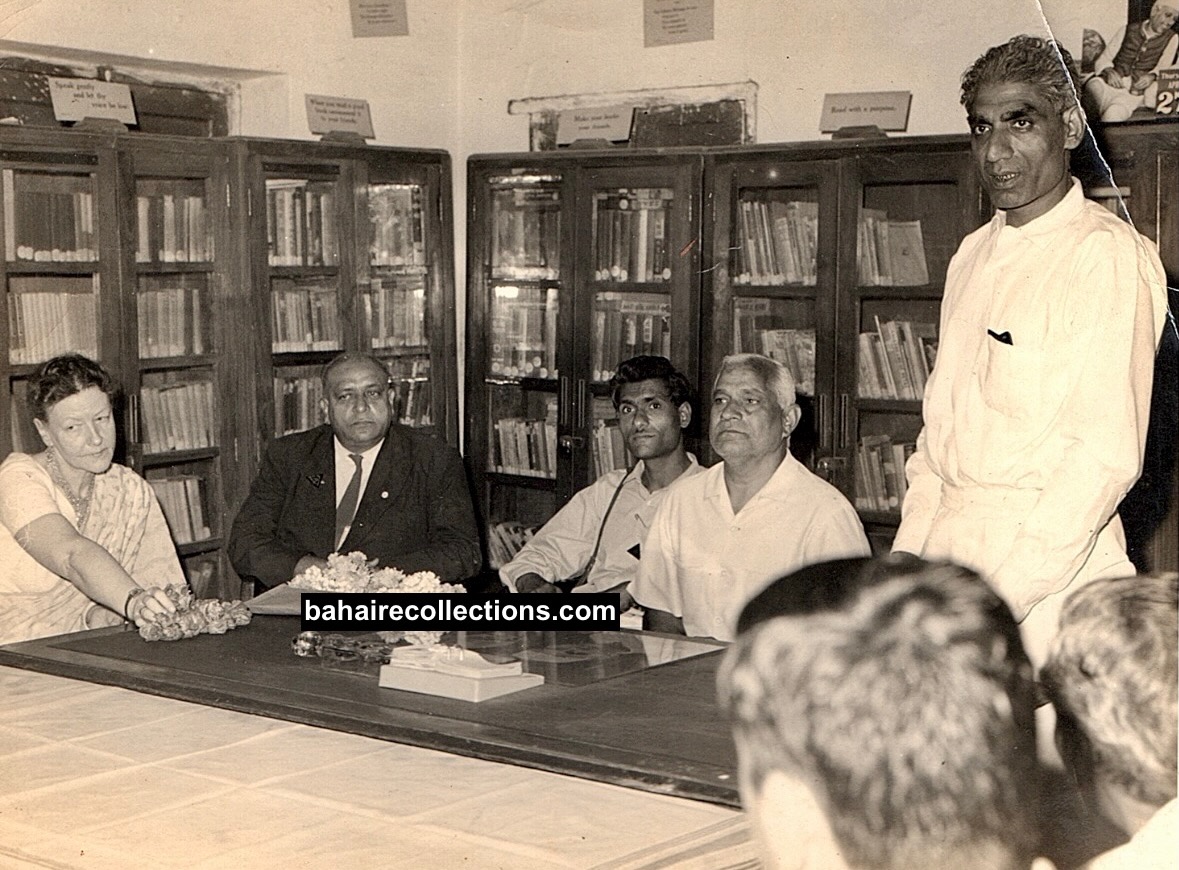
Hand of the Cause Amatu’l-Bahá Rúhíyyih Khánum at the extreme left with Dr. Munje next to her during her visit to India in 1964.
His favourite topic was fulfilment of prophecies as mentioned in all the past religions. He would go as far as quoting from the Hindu scriptures pertaining to the Revelation received by Bahá’u’lláh in the Siyáh-Chal, including the exact days when He was incarcerated there. Such was the depth of his study. Many questions were posed to him on Sanatana Dharma or ‘Eternal Religion’. Friends were really infused and inflamed with the fire of the love of Bahá’u’lláh. That prompted him to write books on the Hindu Faith.
That he was a highly knowledgeable person was widely known at local and international levels, including Hands of the Cause of God. When Amatu’l-Bahá Rúhíyyih Khánum represented the Universal House of Justice at the first National Convention of Andaman Islands, she spoke to Tina, the eldest and the only granddaughter of Munje at the airport. Amatu’l-Bahá Rúhíyyih Khánum had this to say to Tina, “Tina, he’s not only a knowledgeable man, but he’s also one of the most, knowledgeable Baháʼís that we have in this world today. And you should be proud to be his granddaughter.”
A GREAT TEACHER
Teaching remained Dr. Munje’s pivotal passion, aim and objective in life. He started his teaching activities at the very early stage of the establishment of the Faith in India. He was one of the first believers of Bombay who started mass teaching in the early 1960s. For 50 years there was not one month during which he did not leave his home to serve the Cause. His humility was evident in his willingness, despite his broad knowledge, to learn from others.
The couple started mass teaching in Kanpur and its surrounding villages with great success. When mass teaching was initiated by Hand of the Cause of God Dr. Muhájir in the 1960s, he was in the forefront with many others, bringing and enrolling hundreds of thousands of friends into the Faith, especially in the states of Madhya Pradesh and Uttar Pradesh. Following that he helped to establish thousands of Local Spiritual Assemblies in those regions. Teaching and consolidation went on simultaneously. Deepening institutes were established. The Indore Institute is a famous one and it remained a permanent institute for many years. When Dr. Muhájir asked Dr. Munje to go to Indore Institute, he immediately left his well-established Kanpur practice to go there. He stayed at Indore Institute for over six months. In 1966 Dr. Munje who was serving as an Auxiliary Board member gave the Message to the staff and students of a Tibetan Refugee School in Mysore, India.
He was very focused on deepening the friends and it became a passion for him. He visited and participated in Bahá’í programmes in almost all the States of India. He had a prepared package of over a hundred subjects and topics from which persons or groups could select a talk which they deemed suitable to their gathering. With individuals or small groups, he would listen to people for hours. Then when he spoke to them, they were enthralled by his knowledge. He would literally spend weeks, months, or even years teaching an individual at any time of the day or night, often discussing the Faith with a man all night.
ELOQUENT SPEAKER
Dr. Munje was a spellbinding, powerful, and well organized public speaker, capable of expounding on a wide variety of subjects, convincing the masses listening to him. Dr. Munje spoke to general audiences as well as specialized groups with equal confidence. He simply spoke with such a fervid eloquence that the listeners were captivated. A talk he gave at the Spiritual Summit Conference held in Merton in Calcutta in October 1968 would be sufficient for one to pause and reflect at his oratory skills. Representing the National Spiritual Assembly of Bahá’ís of India, he presented a paper on “A Bahá’í Viewpoint” at the conference. He spoke, “The most important and emergent question of the world today is a planetary solution for the whole of mankind, for a living peace and justice in action. Indeed, the lessons of two world wars have not sufficed to bring mankind to its senses. We are numbed with fear and do not want to dwell on the awesome reality of atomic warfare. Philosophies, economic systems, and politicians have led us nowhere. It is crucial for mankind to find out whether religion has the answer. Hence the question of relevance to modern society; the economic plight of the world and the injustices we see everywhere. How powerful is religion to revive the failing fortunes of a harassed humanity?”
He gave talks in Rotary and Lions Clubs, law associations, universities, colleges, women’s groups, writers’ and journalists’ groups. When he visited different States in India he ensured that he met people of capacity and dignitaries such as the Chief Minister, Governor, or other Ministers with portfolios. In his later years of life too he kept on involving himself in such activities, as it was rare to find others who could do so. In fact, to my mind he was himself a dignitary and person of capacity. Wherever he went, people who met him could never forget him and his personality.

Dr. Munje speaks at the World Religion Conference, Lucknow in 1977.
His sense of humour was definitely one of his distinguishing characteristics. He gave his talks according to the audience and in most cases he would add wittiness to his talks to keep the crowd in stitches that they would be ready to listen to him for a long time. People would understand him very fast through the wittiness that he employed in his talks. That high sense of humour was a virtue that attracted many to him. He was fond of using analogies to substantiate his points.
SOME MEMORABLE GATHERINGS
Dr. Munje was at major Bahá’í gatherings of India from the very early days. As it would not be possible to list down each of those gatherings I wish to state some.
The ninth session of the Summer School was held in Karachi from October 9 to October 23, 1946, with participants representing fifteen centers. There Dr. Munje spoke on “Station of the Prophets.” Outside activities during this school session were lectures given by Dr. Munje at a Hindu High School and at a Polish Refugee Camp. These talks were so well received that the organizers returned a second time by request him to speak on the Faith. The National Spiritual Assembly later sent a Polish translation of the book Bahá’u’lláh and the New Era to the camp.
In 1958, Dr. Munje and his son gave two lectures – one at the Devlali High School and the other at the Rotary Club. Devlali, is a small hill station and a census town in Nashik district of the Indian state of Maharashtra. The latter talk resulted in an invitation by the president of the Rotary Club and the president of the Literary Society to give a Bahá’í lecture to the Literary Society, composed of military officers and their wives. Two other high schools, with audiences of 300 and 1000 also heard Dr. Munje speak on the Bahá’í Faith with several fireside discussions following. In 1962, representatives from several villages attended a week-long study course in Sholapur, India with Dr. Munje as the instructor who coordinated the study.
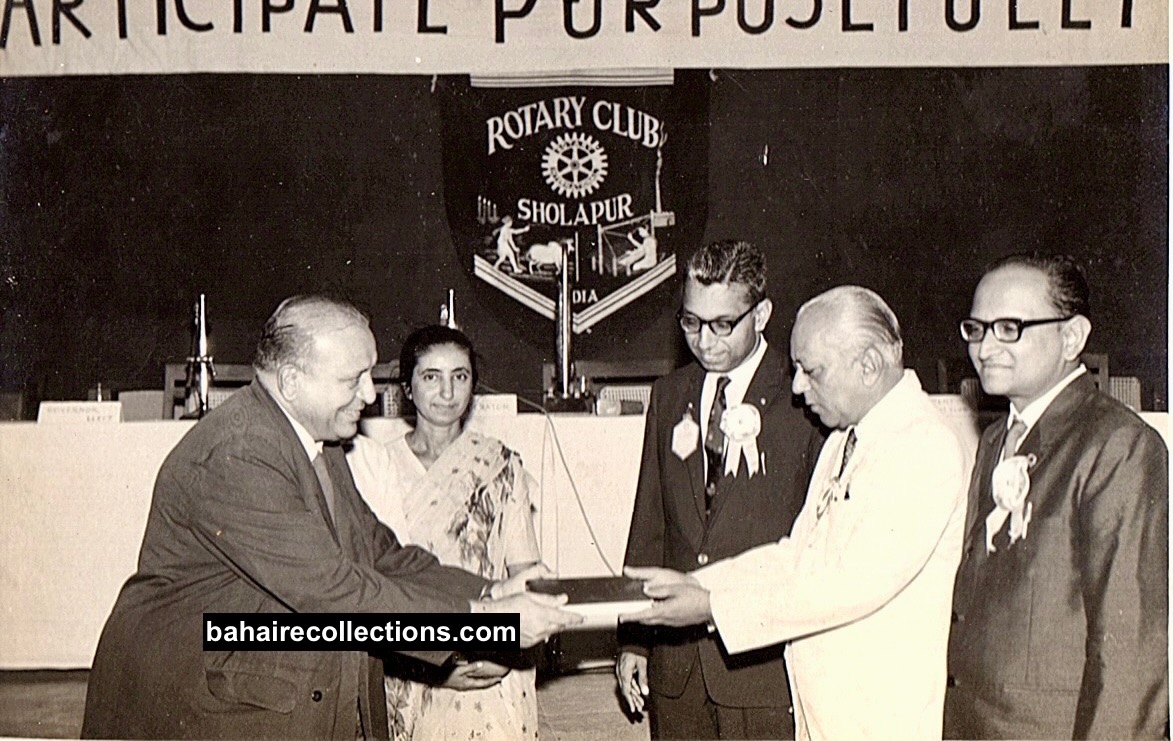
Dr. Munje with Mrs. Banu Jehani presenting a book to the Rotary Club in Sholapur.
Dr. Munje as member of the National Spiritual Assembly of India visited Baroda for five days during June 1969. Almost all the leading newspapers of Baroda and Surat published the news of each of his lectures at the University, Mahavir Vidyalaya, Rotary Club and a public meeting at the Jubilee Garden where 3,000 people attended.
On 25th of December 1971 the Bahá’í youth gathered at the Mala’s Hotel in Panchgani ‘to live the Bahá’í community life’ at the Winter School held through the 30 December. The youth deepened their knowledge of the Faith through the learned and distinguished teachers including Dr. Munje.In May 1972 a successful Forth National Youth Conference was inaugurated by Hand of the Cause Mr. A. A. Furútan and aided by the presence of Counsellor S. Vasudevan, National Assembly representative Dr. Munje and Auxiliary Board members B. Afshin, Mrs. S. Kermani and S. B. Mobedzadeh. Press reporters were present in one of the sessions of the Conference and the proceedings of the gathering appeared in five leading newspapers.
When the Local Spiritual Assembly of Lucknow sponsored a proclamation in the summer of 1975 it brought about unprecedented publicity in India. All four members of the Continental Board of Counsellors in South Central Asia participated in the proclamation. They are Counsellors Zena Sorabjee, Shirin Boman, Salisa Kermani and Dipchand Khianra. In addition to the Counsellors, Bahá’í speakers included Gloria Faizi, Charles MacDonald, Ray Johnson, and Dr. Munje.

Intercontinental Conference in New Delhi, 1967. Seated L-R: Mrs. Shirin Boman, Hand of the Cause of God Dr. Muhajir and Dr. H. M. Munje.
EXTENSIVE TRAVELS
Not many in India would have travelled the length and breadth of the county as Dr. Munje did which is not to be covered in this story. Dr. Munje also undertook international travels for the Baháʼí Faith. In the 1960s he had travelled to Pakistan, Afghanistan and England and even to Iran — just before the revolution. At all these places, many public talks were arranged in universities, Rotary Clubs, and other organisations that had similar aims as that of the Bahá’í Faith.
In 1971 he went to Mauritius. The Mayor of Vacoas and Phoenix received the Bahá’ís in his office and signed the declaration proclaiming the 24th of October 1971 as The United Nations Day of the International Year for Action to Combat Racism and Racial Discrimination. At a tea party attended by the United Nations Representative in Mauritius and the Chairman of the National Spiritual Assembly of India, Dr. Munje, talked on the activities of the United Nations and the part played by the Bahá’ís to promote United Nations activities. The National Spiritual Assembly of Mauritius organized a public exhibition at Ghandi Ashram Hall in Vacoas where Dr. Munje spoke on “Man One Family.”
He attended the first National Convention of Nepal in Ridván 1972, representing the National Spiritual Assembly of India. Representing the Universal House of Justice was Hand of the Cause of God A. A. Furútan, who read the message from the Supreme Body. Dr. Munje, representing the National Spiritual Assembly of India remarked that “Prayer is your powerhouse and the National Spiritual Assembly is the power-driven machinery. You must constantly pray to receive more power.”
From 18 to 20 October 1978, Dr. Munje represented the national institution of India at the centenary celebration of the establishment of the Bahá’í Faith in Burma held at the Bahá’í National Center in Rangoon. More than 1,700 believers attended the event. The Burmese Bahá’í community is among the oldest in the world, having received its first Bahá’í teacher, Jamál Effendi in 1878 at the instruction of Bahá’u’lláh Himself.
He also visited Uganda, Kenya and Tanzania in 1971 first and later in 1976, for one year, where many programmes were arranged for him, including gatherings with the Indian communities, colleges and universities, Rotary and Lions Clubs and Law Associations. During the last days of his stay in East Africa Dr. Munje travelled the length and breadth of East Africa. Upon returning to India, he travelled to a number of places in India to share what he had learned and observed about the people of Africa who were so receptive to the Faith.
His second trip to Malaysia was in 1982 and visited several communities including Petaling Jaya and Penang. A special gathering at the prestigious Hilton Hotel in Kuala Lumpur for the believers to meet him for a discussion on Hinduism. In Malaysia he met Baháʼís from Indian, Chinese, and other indigenous backgrounds. He spoke in many places about Hindu concepts, Buddhism and Christianity, and their relationship with the Baháʼí Faith. Many were inspired by his talks as he was able to quote from Hindu and Buddhist scriptures, as well as from the Qur’an and the Gospel, all from memory. The Malaysian believers saw him as a distinguished person with vast knowledge on comparative religion.
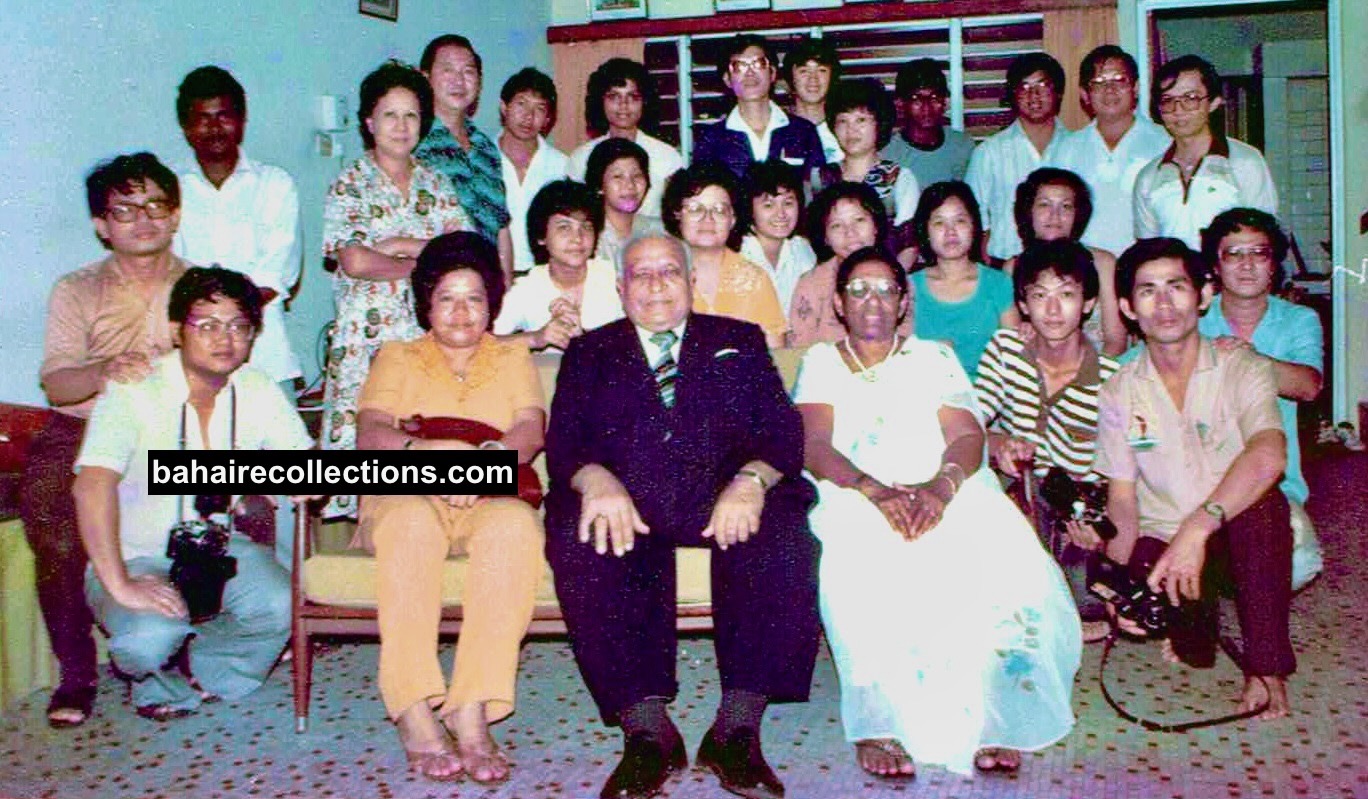
Dr. Munje with the believers of Penang, Malaysia, 1982.
SERVED IN SEVERAL CAPACITIES
Dr. Munje had served in various capacities in India. He was on the National Spiritual Assembly of India for more than 20 years, starting from 1960 to 1986, except for the years 1965-66, 1966-67, and 1977-78. In 1966 he served as an Auxiliary Board member. Dr. Munje was much of that time as Chairman. He was a firm believer in the art of consultation and never failed to stress the fundamentals of the Faith from the Writings. He would never get angry or annoyed at others when contrary ideas were put forth. On the request of the national institution, he had undertaken vast travels, at times to solve very complex problems in some communities.
He also served on the Baháʼí Publishing Trust Committee of India for about two years. He was always encouraging the production of Bahá’í books. He would often help in reviewing manuscripts.
MAN OF RARE TALENTS
Not many would know that Dr. Munje was also a well-known poet in Hindi and Urdu and was often invited to the literary “Kavi Sammelan” and “Mushaira” meets. All the songs he wrote out were spiritual and inspired by the Baháʼí Writings. They were always highly appreciated by the listeners. He had written many songs and poems in Hindi, English, Gujarati, and Urdu.
He was a great man and yet simple in many ways. He had a simple heart like a child. He was always with a spontaneous joy, and all he wanted was to make others happy. He would relate jokes to bring cheer to those around him. He would come to the National Baháʼí office in New Delhi as an ordinary man, without any pomp. On many occasions he slept in a small room somewhere in the corner. He did not look for any comfort. At times he slept in the hall on the floor, laying down his mattress himself. He was very simple as far as his personal needs were concerned. He had a special aluminium suitcase. Sometimes at busy railway stations when it was so crowded that there was no place to sit, he used this suitcase to sit on, and it was strong enough to take his weight.

A great Dr. Munje addresses the simple village people.
He was never proud or arrogant; rather, he was a mountain, an ocean of patience. He was a man of humility who believed in others and treated them with respect, never getting angry. He was gentle, kind, loving and hospitable. He never looked at the status or background of people. He loved all, regardless of background. He had the ability to transcend and shun barriers and acquaint himself with every situation.
He had the talent to address people from all backgrounds -from the most literate to the most common man. Once in Andhra Pradesh he easily travelled in a cycle rickshaw and went around teaching despite his heavy body. He did not care for the numbers. If there was one enquirer who wanted to know about the Faith, he would go looking for him. And if he had to address a large crowd, he was comfortable as well. At a Peace conference organised in Jamshedpur in 1984, he addressed a crowd of some 3,000 people on his ideas with quotations from Hinduism, Christianity, the Bahá’í Faith and Islam, on how to establish world peace. People of different races, different castes, different creeds, and different religions. They ranged from the illiterates in the villages and slum areas to the highly educated and even priests. He had no fear of the stage or the crowds. And whenever he spoke, an hour with him was like a few minutes as he was such a speaker with penetrative impact.
When visiting villages, he was happy with whatever meals he was offered. He attended conferences not only in big cities, but also in the most remote villages of India. He did not care about status, position, or lots of respect from others. His manners were very humble. Dr. Munje could have travelled through first class train tickets, but he travelled second class three tier to save money. Even at his advanced age he would travel, without seeking assistance from anyone.
Perhaps Dr. Munje was one who had attended most of the conferences in India. Dr. Munje had participated in several conferences as a speaker and had impressed the audience with his insightful thoughts.

National Youth Gathering in Pune, 1971. Dr. Munje is seated in the centre.
Although Dr. Munje was most loving a person, his sense of justice was very strong. He was a very courageous person that he would not allow injustice to creep in any way. In 1976 he visited the Patna Bahá’í Centre in the state of Bihar on behalf of the National Spiritual Assembly to negotiate the purchase of the first State Bahá’í Centre. He met the owner and studied all the papers. It was an old two story building with a large hall and about ten rooms, right on the main road. Half way through the negotiations the owner wanted to back out, apparently someone wanted to pay more. Because a preliminary document of intent was already signed by both parties and because of Dr. Munje’s had legal background he did not let other party withdraw. He threatened them with litigation if they did not go through the deal. Thus, we got the Centre for Bihar. A few years later the building was sold for double the price and we bought a Centre in a better location. Where he had to be firm, he showed the force of strength.
MEETING DIGNITARIES
He was very good in winning the hearts of the dignitaries. Dr. Munje was also a great friend of many dignitaries of India such Dr. S. Radhakrishnan and Dr. Zakir Hussein, respectively the second and third Presidents of India. He was also a friend of Pandit Jawaharlal Nehru, first Prime Minister of India.
Dr. Munje was almost always on the Bahá’í delegations that called upon those highest in authority in India. To mark the centenary of the Proclamation of Bahá’u’lláh to the Kings of the world, the National Spiritual Assembly of India presented copies of the book The Proclamation of Bahá’u’lláh to several dignitaries in 1968. On 22 May 1968, a copy of the book was presented to Dr. Triguna Sen, Minister of Education of India. Present were Auxiliary Board member Dr. Perin Oliyai, Dr. Tahira Vajdi and Dr. H. M. Munje. Dr. Sen showed an interest in the teachings of the Cause and requested books on the subject so that the teachings could be incorporated in the curriculum of the schools throughout India.

Dr. Munje with the King of Mandi, .
In May 1980 the Bahá’í community of India began its celebration of the hundredth anniversary of the establishment of the Faith on the subcontinent. The minister for Home, Shri. Giani Zail Singh, and the Minister for Foreign Affairs, Shri. P. V. Narasimha Rao arrived and praised the Faith in their speeches. The Bahá’í speakers were Dr. H. M. Munje and Dr. S. Vasudevan who spoke in Hindi and English, respectively. Delhi TV included mention of the celebration in its newscast. Widespread publicity appeared in the next morning’s newspapers as well as on radio. The national radio networks carried the news throughout the country.
In 1982 Dr. Munje was part of a delegation that went to meet the Minster of Education in Orissa state. Dr. Munje explained to him the principles of Baháʼí education and the importance that is given to moral education. The Minister was so impressed that he asked for the Bahá’ís to teach moral education to all the schools in Orissa. That would be a gigantic task which numbered thousands at that time! On the request of Dr. Munje a pilot program was approved. The Minister wrote a letter to the Director of Education to start off the program in Bhuvaneswar, the capital city. The Director in turn issued letters to the 14 schools in Bhubaneswar to hold sessions on moral education with Dr. Munje. So, the program began, Dr. Munje would tell them stories and explain topics from moral education. Throughout his life Dr. Munje was always meeting some dignitaries.

Visit by Hand of the Cause of God Mr. Enoch Olinga to India in 1964. The hand is seated third from left with Mrs. Elizabeth Olinga at the extreme left, and their two children. Dr. Munje is seated at the extreme right.
When the Peace Statement was issued by the Universal House of Justice in 1986, Dr. Munje and Mrs. Bharti Gandhi, representing the National Spiritual Assembly of India presented the statement to the Dalai Lama of Tibet at Bodhgaya, India. Dr. H. M. Munje reported to the National Assembly that “… His Holiness appreciated the Bahá’í Teachings and remarked that the timely issuing of the peace statement will greatly help in moulding world opinion in favor of peace and international understanding.”
UNFULFILLED WISH
Dr. Munje had always wanted to be a pioneer and have his bones buried at the pioneering post, which was fulfilled and his mortal remains are buried in Kanpur. But he wished to again go on pioneering . One day in 1985 he arrived at the Office of the Baháʼís of India in New Delhi with his bag and baggage. He arrived there to prepare to go to Papua New Guinea for pioneering since there was a call for pioneers to that country. His close friends were very surprised to see the spirit of Dr Munje who was already of advance age wanting to pioneer at that age to such a challenging and difficult place like Papua New Guinea. Dr. Munje’s spirit was really remarkable. The members of the National Spiritual Assembly though admired the missionary zeal in him spent some time persuading him not to go pioneering on account of his age. Finally, Dr. Munje returned to his home, quite disappointed.
HIS PASSING
In 1987, his beloved wife died. He was very sad on her passing. He used to say this of her, “Always upholding, supporting, and cooperating in all our affairs in times of happiness and sorrow; that is the kind of woman my wife Nalini was. Thus, I had the freedom to move around to carry forth the Baháʼí activities.”
Dr. Munje did not go on pilgrimage to the Holy Land during Shoghi Effendi’s lifetime, but he carried on an extensive correspondence with the Guardian. In approximately 37 letters Shoghi Effendi encouraged him to pioneer, to write books, to research Hinduism and how it related to the Bahá’í Faith, and to teach Hindus.
Then in 1988 he went on his second pilgrimage to the Holy Land with the Rost family. The first time he had the bounty to go on pilgrimage as a member of the National Spiritual Assembly to the International Convention. During his last days, bedridden in a hospital in Kanpur for heart ailments. When the doctors wanted to give him an injection, he rejected saying, “Injection is harmful for my body because my body is addicted to only homeopathy medicine and allopathic doesn’t suite my body”. Instead, he would ask visitors to sing prayers in praise of Bahá’u’lláh. When the singers missed certain lines, Dr. Munje would stop them and point out the correct lines. Although his health was failing, his memory was keen and alert. While hospitalised Dr. Munje resigned to the Will of God. The night before he ascended to the Abhá Kingdom, he was talking to his grandsons about what Zoroaster had said – that there is only One God – the Omnipotent, the Creator. He passed away in the arms of Radha and John, one of his grandsons on 19 June 1989. A very great man had gone to the Abhá Kingdom.
The Universal House of Justice sent a message that read:
GRIEVED PASSING STALWART PIONEER TEACHER PROMOTER CAUSE DR. H. M. MUNJE. HIS DEVOTED SERVICES MANY FIELDS HIS LEARNED EXPOSITION FAITH IN MANY LANGUAGES HIS EAGERNESS TO ANSWER CALL DUTY AT ANY MOMENT AND ABOVE ALL HIS RADIANT FAITH IN BLESSED BEAUTY REMAIN AS EXAMPLE FOLLOWERS GREATEST NAME IN INDIA. ASSURE BELOVED FAMILY FRIENDS ARDENT PRAYERS HOLY SHRINES PROGRESS HIS SOUL ABHA KINGDOM
Dr. Munje had been Baháʼí for a long time and spanning many decades. He moved across the country as a colossal figure. During his lifetime he had met many internationally prominent Bahá’ís such as Hands of the Cause of God. He met Hand of the Cause Dorothy Baker in the 1950s when she came to India. Dr. Munje was a translator for her during some of her travels and the times when she addressed various audiences. Another great teacher, Miss Martha Root, came to India in the 1930s and Dr. Munje may have translated for her. He met Hands of the Cause of God Shu’á’u’lláh ‘Alá’í at the national convention of India of 1962, where Dr. Munje was elected to the national institution. He was with Hand of the Cause of God Mr. Tarázu’lláh Samandarí in the presence of the Bahá’ís of Srinagar (Kashmir) on May 14, 1966. He associated with the many Hands of the Cause of God who arrived on Indian soil, including Mr. Abu’l-Qásim Faizi, Shu’á’u’lláh ‘Alá’í, Amatu’l-Bahá Rúhíyyih Khánum, Mr. William Sears, Enoch Olinga, Dr. Muhájir and many other Hands of the Cause at various occasions such as Mr. Musá Bánáni in Uganda and Mr. Furútan in Haifa.
Dr. Munje’s devotion to the Faith was unquestioned. He would arise before dawn for prayers each day and would pray for long periods of time. He would not attack or condemn any institution or individual; instead he remained silent.
Throughout his life Dr. Munje prayed for himself and for others in distress. He used to get up at 4:30 in the morning and perform his Obligatory Prayer. Throughout his life he was a very organised person always doing things meticulously. He would never stop working and took pains to reply to all letters and enquiries.
Throughout his life Dr. Munje also kept writing to defend the Cause against the assailants. Bahá’u’lláh has said, “If any man were to arise to defend, in his writings, the Cause of God against its assailants, such a man, however inconsiderable his share, shall be so honored in the world to come that the Concourse on high would envy his glory. No pen can depict the loftiness of his station, neither can any tongue describe its splendor.” I am sure Dr. Munje is richly rewarded in the next world for defending the Cause of Bahá’u’lláh on this earthly plane.
Suffice to say that the generation to which Dr. Munje belonged to was before ours. The services of great souls such as Dr. Munje laid the foundation for the present-day Indian Baháʼí community. They all have to be remembered, recalled and admired for the indelible legacies they left for the current and future generations to emulate.
Dr. Radha Rost
Panchgani
Maharashtra
India
31 December 2023
About the author:
Born and brought up in a Bahá’í family she was encouraged and guided by her parents and grandmothers. Her father Dr. H. M. Munje is one of the greatest scholars and teachers of the Faith in India. She studied medicine and has master’s degree in general surgery. She worked for 7 years in the Government hospitals and medical colleges in the city of Kanpur in India. She pioneered to Uganda in 1971 where she met Dr. H. T. D. Rost, an American pioneer whom she married in the same year. This marriage produced three sons. In 1973 the couple moved to Kenya. There she worked as as Senior Medical Doctor for some 12 years in the Kenyatta University College. In December 1984 they went to Panchgani, India to start the New Era Development Institute on the instructions of Office of Social and Economic Development. Dr. Radha worked there till 2004. She is currently working at New Era High School in Panchgani, India.
Copyright©bahairecollections.com
You may leave your comments at: info@bahairecollections.com
